 The intersection of two backstreets in Newtown is a smeary mess of white paint, but walk around it and you will find the right angle to decipher the name ‘Maria’. Close by, ‘Jen’ has written her name more neatly. What inspired Maria and Jen to leave their autographs here? Probably a tin of white paint found discarded nearby. There is no sign of the paint can now, but  the offending ‘paintbrushes’ are still on display – branches nicked from a shrub in someone’s garden, defiantly attached to a light pole on the corner.
The intersection of two backstreets in Newtown is a smeary mess of white paint, but walk around it and you will find the right angle to decipher the name ‘Maria’. Close by, ‘Jen’ has written her name more neatly. What inspired Maria and Jen to leave their autographs here? Probably a tin of white paint found discarded nearby. There is no sign of the paint can now, but  the offending ‘paintbrushes’ are still on display – branches nicked from a shrub in someone’s garden, defiantly attached to a light pole on the corner.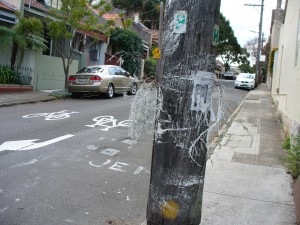
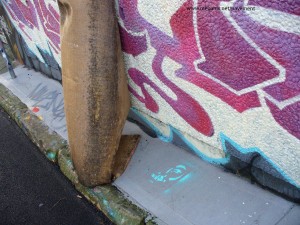 The wall art in May Lane is often in the news. This time it’s on page three of the Sydney Morning Herald because there is going to be a national tour of panels from this laneway in St Peters, setting off in October. It all started about five years ago with Tuli Balog encouraging graffiti writers to do pieces on the wall of his picture-framing factory. Kurt Iveson has written about it in his book Publics and the city (Blackwell Publishing, 2007).
The wall art in May Lane is often in the news. This time it’s on page three of the Sydney Morning Herald because there is going to be a national tour of panels from this laneway in St Peters, setting off in October. It all started about five years ago with Tuli Balog encouraging graffiti writers to do pieces on the wall of his picture-framing factory. Kurt Iveson has written about it in his book Publics and the city (Blackwell Publishing, 2007).
 But the graffiti on the pavement in May Lane is never mentioned. Walk up and down the lane, though, and you will find all sorts of deliberate and accidental art decorating the gutters, along with the signatures of people whose wall pieces have long since been covered over.
But the graffiti on the pavement in May Lane is never mentioned. Walk up and down the lane, though, and you will find all sorts of deliberate and accidental art decorating the gutters, along with the signatures of people whose wall pieces have long since been covered over.
POSTSCRIPT – Since I wrote this post, May Lane has become the subject of discussion at Marrickville Council (not for the first time). Here’s a report by an onlooker of the discussion at the meeting on 9 November 2010. It’s on the Saving Our Trees website, although I don’t quite get the connection.
This inscription has me baffled. Godot, the graffiti-spotting cabbie, saw it first and posted on his Flickr site. It’s in Wilson Street, Darlington, near Eveleigh, and it reads Eco-cycle Rapists. The style of writing is accomplished and familiar but what does it mean? Who or what is it defaming – or advertising? 
(Eco Cycle, by the way, is the brand name of an electic-powered bicycle that has a “rechargeable lithium battery and electric motor which cuts in when you flake outâ€).
Wilson Street was a popular inner western route to the city long before it was officially stamped as such with the large white bicycle stencils. Dozens of cyclists earnestly pedal over these words daily. Do they notice them?
 Here is a photograph from the archives. I took it in October 1999, before I owned a digital camera and when sometimes I took only one shot of each pavement embellishment I spotted. How I regret that!
Here is a photograph from the archives. I took it in October 1999, before I owned a digital camera and when sometimes I took only one shot of each pavement embellishment I spotted. How I regret that!
This solitary metal plaque is just a few centimetres long (compare its size with the blobs of chewing gum on the asphalt). It’s on the footpath outside a shop in King Street, Newtown, south of the railway station and opposite the high school. At least it used to be there, but it disappeared when the pavement was upgraded some years ago. A number of people have mentioned it to me when they hear I take photos of pavement inscriptions and most know that it commemorated a girl (or woman) who was killed by a car that mounted the footpath.
Recently I tried to find out a bit more of this story. In the Glebe and Inner City News of 19 June and 26 June 1996 I read that Newtown woman Alison Gooch was killed when hit by a car as she walked along the footpath at about 3 am on Sunday 16 June. The car then hit a power pole before plunging through the front of the Direct Image store at 361 King Street. A 25-year-old Bondi man was subsequently charged with dangerous driving causing death and driving under the influence.
In the register of funerals at St Stephens Church, Newtown, it is recorded that a service was held for Alison Joy Gooch of Station Street, Newtown, on 21 June 1996. Alison was 29 years old.
I don’t know who fixed the memorial plaque to the footpath.
 Camperdown Park, in inner western Sydney, is famous for the graffiti on the sandstone walls separating it from the St Stephens Church Cemetery. I have a book published in 1975 (Ellis & Turner, Australian Graffiti) with a black and white photo of graffiti messages in large lettering on this wall like ‘Love is a many gendered thing’ and ‘Is there life after marriage?’
Camperdown Park, in inner western Sydney, is famous for the graffiti on the sandstone walls separating it from the St Stephens Church Cemetery. I have a book published in 1975 (Ellis & Turner, Australian Graffiti) with a black and white photo of graffiti messages in large lettering on this wall like ‘Love is a many gendered thing’ and ‘Is there life after marriage?’
These days the political and often witty statements have been joined by more up-to-date styles of graffiti like ‘balloon’ lettering and stencils. The graffiti has also crept onto the paths in the park. It soon gets obliterated by pedestrians and cyclists, but three years ago I happened to capture the faint remnants of this one, which seems to have been written by a person who was either very happy, or needed to make a statement, or both.
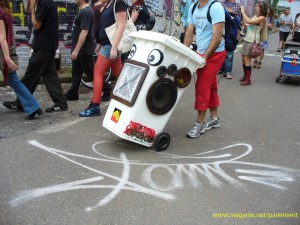 If they won’t let you Reclaim the Streets any more, then Reclaim the Lanes instead. It’s a bit sad really. The RTL party on 13 February was small but kind of fun anyway, even if everyone was funnelled into just one lane not far from the starting point. There were balloons, bikes, and budgie smugglers. When it became apparent that the procession had come to a halt people started sloping off to the bottlo in Enmore Road for supplies. The music from wheelie bin sound systems was great. And someone stuck up their photographs of the Reclaim the Streets events in Newtown from 1999 and 2000 to remind everyone what it used to be like.
If they won’t let you Reclaim the Streets any more, then Reclaim the Lanes instead. It’s a bit sad really. The RTL party on 13 February was small but kind of fun anyway, even if everyone was funnelled into just one lane not far from the starting point. There were balloons, bikes, and budgie smugglers. When it became apparent that the procession had come to a halt people started sloping off to the bottlo in Enmore Road for supplies. The music from wheelie bin sound systems was great. And someone stuck up their photographs of the Reclaim the Streets events in Newtown from 1999 and 2000 to remind everyone what it used to be like.
The back lanes of Enmore and Newtown are best known for their wall art, but there is stuff on the ground as well, mostly the signatures of artists who have done the wall pieces. I took photographs of RTL participants partying on the remnants of old pavement graffiti.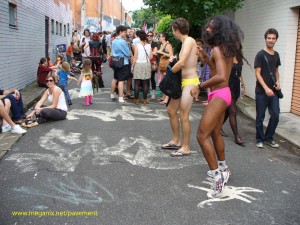
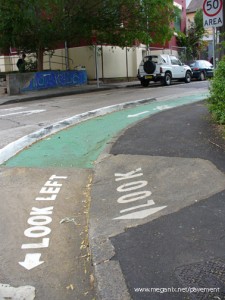
Wilson Street, Newtown
LOOK LEFT for motor vehicles. Oops! Sorry about the bicycle that just crashed into you from the right.

Bourke Street, Surry Hills
Â
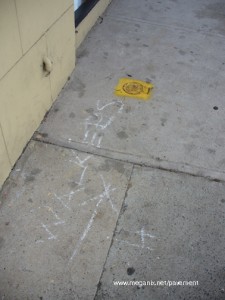 Arrow chases are the urban version of Hare and Hounds. Kids chalk arrows on the pavement instead of leaving paper trails, and Hash House Harrier clubs sometimes write esoteric instructions beside their arrows. I spotted the ‘Walkers’ arrow near Stanmore Station.
Arrow chases are the urban version of Hare and Hounds. Kids chalk arrows on the pavement instead of leaving paper trails, and Hash House Harrier clubs sometimes write esoteric instructions beside their arrows. I spotted the ‘Walkers’ arrow near Stanmore Station.
AF remembers being on a run with his club some years ago in Melbourne when the arrows petered out near a tram stop. Not knowing what else to do the group of sweaty runners got onto the next tram that came along and rode to the end of the line. There they found that the arrow trail had resumed with the instruction ‘ON ON’.
Â
Arrow chases probably explain many of the chalk arrows you see in the streets, but others are written on the pavement for the benefit of strollers and shoppers, pointing the way to shops, markets and garage sales. These arrows come in all sizes with all kinds of text and embellishment. The ‘Psst – garage sale’ arrow and a set of others like it were in King Street, South Newtown, last year.
 
Â
Â
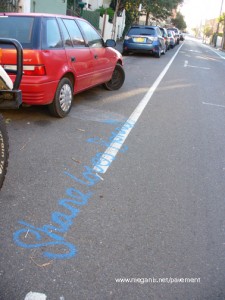 Every so often a large romantic message turns up on the pavement – sometimes on a country road, sometimes on a city street – turning private feelings into blaring headlines. Obviously premeditated and deliberately located so they will be seen by the object of affection (or disappointment), these messages can’t be compared with the miniature declarations of love made by wet cement opportunists. I believe they are generally written by males. Am I right?
Every so often a large romantic message turns up on the pavement – sometimes on a country road, sometimes on a city street – turning private feelings into blaring headlines. Obviously premeditated and deliberately located so they will be seen by the object of affection (or disappointment), these messages can’t be compared with the miniature declarations of love made by wet cement opportunists. I believe they are generally written by males. Am I right?
Shane loves Bonnie was written in Wilson Street, Newtown, in 2008. I photographed Please come home I love you in Surry Hills in 2005 when it had been there for a long time.
I’ve written about public-personal notices in an article in the journal antiTHESIS.
Hicks, M. Hard feelings. antiTHESIS 19 Exhibitionism: 229-233.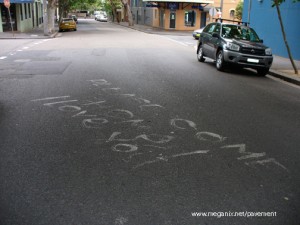
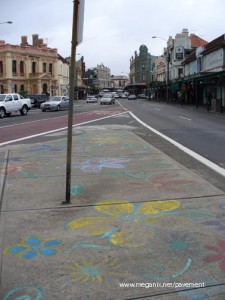 I wonder how many people know the story behind the coloured flowers on the traffic island at Newtown Bridge? They were originally painted during a day-long Reclaim the Streets party in November 1999, but if that were the whole story they would have worn off long ago. In fact, these flowers were deliberately preserved by friends of Kathy Jones.
I wonder how many people know the story behind the coloured flowers on the traffic island at Newtown Bridge? They were originally painted during a day-long Reclaim the Streets party in November 1999, but if that were the whole story they would have worn off long ago. In fact, these flowers were deliberately preserved by friends of Kathy Jones.
Kathy was an artist who worked with advocacy groups for disadvantaged people in the Newtown area. On the day of the Reclaim the Streets demo it was Kathy who organised the decoration of roadways, kerbs and traffic islands at the intersection of King Street and Enmore Road. Â Just a few months later Kathy died. Her friends tied notices to the light poles to let local people know she had gone and coated this particular set of painted flowers with marine varnish. My photograph was taken in 2005 when regular applications of varnish had kept the bouquet fresh for six years. In 2009 the flowers, while still visible, are gradually fading away.